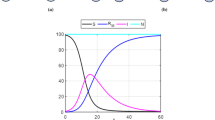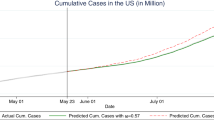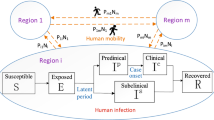Abstract
We developed a model for the spread of Covid-19 within a community, we paid attention to the sensitivity of the derived basic reproduction number to each model parameter. This model was extended to investigate the impact of migration between two communities on the spread of the disease. Three special cases: unidirectional migration, unrestricted bidirectional migration, and partial bidirectional migration, were considered. Covid-19 data for two Nigerian states, namely Lagos (high burden community) and Ogun (low burden community) were obtained from the website of the Nigeria Centre for Disease Control for parameter estimation and simulation. Our results show that the basic reproduction number of the original model is most sensitive to the recovery rate of symptomatic infectious individuals. From the inter-community spread model, we find that the rate of coupling plays a vital role in the control of the pandemic. Our results project the different possible scenarios based on different lockdown and infection rates in two different communities.
Access this chapter
Tax calculation will be finalised at checkout
Purchases are for personal use only
Similar content being viewed by others
References
Abbott, L., Kepler, T.B.: Model neurons: from Hodgkin-Huxley to Hopfield. In: Statistical Mechanics of Neural Networks, pp. 5–18. Springer (1990)
Adeniyi, M., Ekum, M., Iluno, C., Ogunsanya, A., Akinyemi, J., Oke, S., Matadi, M.: Dynamic model of COVID-19 disease with exploratory data analysis. Sci. African 000(e00477), 1–21 (2020)
Agusto, F.B., Bewick, S., Fagan, W.: Mathematical model of Zika virus with vertical transmission. Infect. Dis. Modell. 2(2), 244–267 (2017)
Anastassopoulou, C., Russo, L., Tsakris, A., Siettos, C.: Data-based analysis, modelling and forecasting of the COVID-19 outbreak. PloS One 15(3), e0230405 (2020)
Arriola, L., Hyman, J.M.: Sensitivity analysis for uncertainty quantification in mathematical models. In: Hyman, J.M., Bettencourt, L.M.A., Castillo-Chavez, C. (eds.) Chowell G. Mathematical and Statistical Estimation Approaches in Epidemiology Springer, Dordrecht (2009)
Atkeson, A.: What will be the economic impact of COVID-19 in the us? Rough estimates of disease scenarios. Tech. rep, National Bureau of Economic Research (2020)
Bauch, C.T., Oraby, T.: Assessing the pandemic potential of MERS-COV. The Lancet 382(9893), 662–664 (2013)
Berge, T., Lubuma, J.S., Moremedi, G., Morris, N., Kondera-Shava, R.: a simple mathematical model for Ebola in Africa. J. Biol. Dyn. 11(1), 42–74 (2017)
Bhunu, C.P.: A mathematical analysis of alcoholism. World J. Model. Simul. 8(2), 124–134 (2012)
Blake, P.A.: Historical perspectives on pandemic cholera. In: Vibrio cholerae and Cholera, American Society of Microbiology, pp. 293–295 (1994)
Bowman, C., Gumel, A., Van den Driessche, P., Wu, J., Zhu, H.: A mathematical model for assessing control strategies against West Nile virus. Bull. Math. Biol. 67(5), 1107–1133 (2005)
Chatterjee, K., Chatterjee, K., Kumar, A., Shankar, S.: Healthcare impact of COVID-19 epidemic in India: A stochastic mathematical model. Medical Journal Armed Forces India (2020)
Cucinotta, D., Vanelli, M.: Who declares COVID-19 a pandemic. Acta bio-medica: Atenei Parmensis 91(1), 157–160 (2020)
Dansu, E.J., Seno, H.: A model for epidemic dynamics in a community with visitor subpopulation. J. Theoret. Biol. 478, 115–127 (2019)
De Wit, E., Van Doremalen, N., Falzarano, D., Munster, V.J.: SARS and MERS: recent insights into emerging coronaviruses. Nat. Rev. Microbiol. 14(8), 523 (2016)
Diekmann, O., Heesterbeek, J.A.P., Roberts, M.G.: The construction of next-generation matrices for compartmental epidemic models. J. R. Soc. Interface 7, 873–885 (2010)
Gatto, M., Bertuzzo, E., Mari, L., Miccoli, S., Carraro, L., Casagrandi, R., Rinaldo, A.: Spread and dynamics of the COVID-19 epidemic in Italy: effects of emergency containment measures. PNAS 117(19), 10484–10491 (2020)
Ghosh, S., Bhattacharya, S.: Computational model on COVID-19 pandemic using probabilistic cellular automata (2020) 2006.11270
Glass, K.: Ecological mechanisms that promote arbovirus survival: a mathematical model of Ross River virus transmission. Trans. R. Soc. Trop. Med. Hygiene 99(4), 252–260 (2005)
Gössling, S., Scott, D., Hall, C.M.: Pandemics, tourism and global change: a rapid assessment of COVID-19. J. Sustain. Tourism 1–20,(2020)
Housworth, J., Langmuir, A.D.: Excess mortality from epidemic influenza, 1957–1966. Am. J. Epidemiol. 100(1), 40–48 (1974)
Ivorra, B., Ferrández, M.R., Vela-Pérez, M., Ramos, A.: Mathematical modeling of the spread of the coronavirus disease 2019 (COVID-19) taking into account the undetected infections. the case of china. Commun. Nonlinear Sci. Numer. Simul. 105303 (2020)
Johnson, N.P., Mueller, J.: Updating the accounts: global mortality of the 1918–1920 “Spanish” influenza pandemic. Bull. Hist. Med. 105–115, (2002)
Kapitza, S.P.: A mathematical model for global population growth. Matematicheskoe modelirovanie 4(6), 65–79 (1992)
Kareem, S.O., Ojo, K., Njah, A.: Function projective synchronization of identical and non-identical modified finance and Shimizu-Morioka systems. Pramana 79(1), 71–79 (2012)
Kolebaje, O., Popoola, O., Khan, M.A., Oyewande, O.: An epidemiological approach to insurgent population modeling with the Atangana-Baleanu fractional derivative. Chaos, Solit. Fractals 139, 109970 (2020)
Kraemer, M.U., Yang, C.H., Gutierrez, B., Wu, C.H., Klein, B., Pigott, D.M., Du Plessis, L., Faria, N.R., Li, R., Hanage, W.P., et al.: The effect of human mobility and control measures on the COVID-19 epidemic in China. Science 368(6490), 493–497 (2020)
Kucharski, A.J., Russell, T.W., Diamond, C., Liu, Y., Edmunds, J., Funk, S., Eggo, R.M., Sun, F., Jit, M., Munday, J.D., et al.: Early dynamics of transmission and control of COVID-19: a mathematical modelling study. The Lancet Infect, Dis (2020)
Lanteri, D., Carco, D., Castorina, P.: How macroscopic laws describe complex dynamics: asymptomatic population and COVID-19 spreading. arXiv preprint arXiv:200312457 (2020)
Lau, S.K., Li, K.S., Tsang, A.K., Lam, C.S., Ahmed, S., Chen, H., Chan, K.H., Woo, P.C., Yuen, K.Y.: Genetic characterization of betacoronavirus lineage C viruses in bats reveals marked sequence divergence in the spike protein of pipistrellus bat coronavirus HKU5 in japanese pipistrelle: implications for the origin of the novel Middle East Respiratory Syndrome coronavirus. J. Virol. 87(15), 8638–8650 (2013)
Liu, Z., Magal, P., Seydi, O., Webb, G.: A covid-19 epidemic model with latency period. Infectious Disease Modelling 5, 323–337 (2020). https://doi.org/10.1016/j.idm.2020.03.003
Möhler, L., Flockerzi, D., Sann, H., Reichl, U.: Mathematical model of influenza a virus production in large-scale microcarrier culture. Biotech. Bioeng. 90(1), 46–58 (2005)
Ndairou F, Area I, Nieto JJ, Torres DF (2020) Mathematical modeling of COVID-19 transmission dynamics with a case study of Wuhan. Chaos, Solitons & Fractals p 109846
Nicola, M., Alsafi, Z., Sohrabi, C., Kerwan, A., Al-Jabir, A., Iosifidis, C., Agha, M., Agha, R.: The socio-economic implications of the coronavirus and COVID-19 pandemic: a review. International Journal of Surgery (2020)
Okuonghae, D., Okuonghae, R.: A mathematical model for Lassa fever. J. Nigerian Assoc. Math. Phys. 10(1), (2006)
Organization WH, et al. (2020) Coronavirus disease 2019 (covid-19): situation report, 160
ÖZalp N, Demirci E, : A fractional order SEIR model with vertical transmission. Math. Comp. Model. 54(1–2), 1–6 (2011)
Peng L, Yang W, Zhang D, Zhuge C, Hong L (2020) Epidemic analysis of COVID-19 in china by dynamical modeling. arXiv preprint arXiv:200206563
Pongsumpun, P.: Mathematical model of Dengue disease with the incubation period of virus. World Acad. Sci. Eng. Technol. 44, 328–332 (2008)
Richardson, E.T., Barrie, M.B., Kelly, J.D., Dibba, Y., Koedoyoma, S., Farmer, P.E.: Biosocial approaches to the 2013–2016 Ebola pandemic. Health Human Rights 18(1), 115 (2016)
Rossi C (2002) The role of dynamic modelling in drug abuse epidemiology. Bull. Narc. 54(1 and 2):33–44
Sahu, P.: Closure of universities due to coronavirus disease 2019 (COVID-19): impact on education and mental health of students and academic staff. Cureus 12(4), (2020)
Sharp, P.M., Hahn, B.H.: Origins of HIV and the AIDS pandemic. Cold Spring Harbor Perspect. Med. 1(1), a006841 (2011)
Shim, E., Tariq, A., Choi, W., Lee, Y., Chowell, G.: Transmission potential and severity of COVID-19 in South Korea. Int. J. Infect. Dis. (2020)
Vaillant, L., La Ruche, G., Tarantola, A., Barboza, P., et al.: Epidemiology of fatal cases associated with pandemic H1N1 influenza 2009. Eurosurveillance 14(33), 19309 (2009)
Viboud, C., Grais, R.F., Lafont, B.A., Miller, M.A., Simonsen, L.: Multinational impact of the 1968 Hong Kong influenza pandemic: evidence for a smoldering pandemic. J. Infect. Dis. 192(2), 233–248 (2005)
Wauer, J., Schwarzer, D., Cai, G., Lin, Y.: Dynamical models of love with time-varying fluctuations. Appl. Math. Comput. 188(2), 1535–1548 (2007)
Wu Y, Xu X, Chen Z, Duan J, Hashimoto K, Yang L, Liu C, Yang C (2020) Nervous system involvement after infection with COVID-19 and other coronaviruses. Brain, Behavior, and Immunity
Yu, Y., Zhang, S.: The synchronization of linearly bidirectional coupled chaotic systems. Chaos, Solitons & Fractals 22(1), 189–197 (2004)
Zhao, S., Xu, Z., Lu, Y.: A mathematical model of Hepatitis B virus transmission and its application for vaccination strategy in China. Int. J. Epidemiol. 29(4), 744–752 (2000)
Author information
Authors and Affiliations
Corresponding author
Editor information
Editors and Affiliations
Rights and permissions
Copyright information
© 2021 The Author(s), under exclusive license to Springer Nature Singapore Pte Ltd.
About this chapter
Cite this chapter
Dansu, E.J., Ogunjo, S.T. (2021). Dynamics of Inter-community Spread of Covid-19. In: Agarwal, P., Nieto, J.J., Ruzhansky, M., Torres, D.F.M. (eds) Analysis of Infectious Disease Problems (Covid-19) and Their Global Impact. Infosys Science Foundation Series(). Springer, Singapore. https://doi.org/10.1007/978-981-16-2450-6_18
Download citation
DOI: https://doi.org/10.1007/978-981-16-2450-6_18
Published:
Publisher Name: Springer, Singapore
Print ISBN: 978-981-16-2449-0
Online ISBN: 978-981-16-2450-6
eBook Packages: Mathematics and StatisticsMathematics and Statistics (R0)




